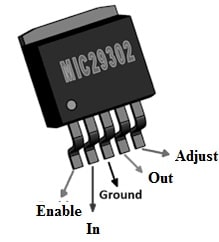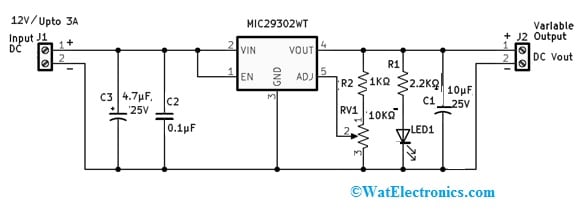The MIC29302 LDO regulator is from Microchip Technology which is a simple low voltage high current regulator. These regulators are used in electronic circuits that need low voltage with a high current input supply. The MIC29302 are high current, low dropout & high accuracy voltage regulators. These LDO regulators feature typical dropout voltages from 350 mV – 425 mV & extremely low ground current with proprietary Super βeta PNP procedure of Microchip. These are mainly used for high current loads, lower current, and very low dropout-critical systems, wherever their small dropout voltage & ground current values are significant attributes. This article provides brief information on the MIC29302 LDO regulator, its working, and its applications.
What is MIC29302 LDO Regulator?
MIC29302 is a low dropout voltage regulator including 3A of maximum current & 450 mV of voltage drop at full load. The main function of the MIC29302 LDO regulator is to control voltage efficiently without decreasing much voltage across the regulator & deliver an output voltage that is very close to the input voltage. The input voltage of this voltage regulator ranges from 3V to 16V whereas the output voltage is from 1.24V to 15V. This regulator is used commonly in high-current battery-based applications because of its zero-current enable mode & low voltage drop.
These LDO regulators are protected completely from reversed input polarity, over-current faults, reversed lead insertion, positive transient, negative transient voltage spikes, and over-temperature operation. These regulators have an error flag & logic-level on/off control which signals when the o/p falls out of regulation.
Pin Configuration:
The pin configuration of the MIC29302 LDO regulator is shown below. This regulator has five pins which are discussed below.

MIC29302 Regulator Pin Configuration
- Pin-1 (Enable): It is a TTL logic pin used to turn on or off the voltage regulator.
- Pin-2 (In): It is an Input voltage pin that is to be regulated.
- Pin-3 (GND): It is a ground pin that is connected to the system’s ground
- Pin-4 (Output): It is a regulated o/p voltage pin.
- Pin-5 (Adjust): This pin is used to set the o/p voltage with two resistor divider networks.
Features & Specifications:
The features and specifications of the MIC29302 LDO regulator include the following.
- It is a 3A LDO variable regulator IC.
- Its input voltage supply ranges from 3V – 16V.
- Its output voltage ranges from 1.24V – 15V.
- Its continuous o/p current is 3A.
- Its Drop-out voltage at 3A is 450mV.
- Its enable logic HIGH is 2.4V.
- Its enable logic LOW is 0.8V.
- It is available in To-252 & To-263 Packages.
- Its high current capacity is 3A above the full temperature range.
- Its low dropout voltage at full load is 450mV.
- Its type of package is surface mount.
- Its Quiescent current is from 0.002 to 0.03 mA.
- Its operating temperature ranges from -40 to 125 Degree C.
Equivalent & Alternatives;
Equivalent of MIC29302 LDO regulators are; MIC29750, MIC29300 & MIC29500 whereas alternative MIC29302 LDO regulators are; LP2985, MIC5225 & AMS1117.
High Current Low Voltage based Regulator Circuit using MIC29302
A very simple high current and low voltage-based regulator circuit is shown below. This circuit is designed mainly with MIC29302. So a simple and cost-effective circuit is designed with fewer components.
The required components to make this circuit mainly include; capacitors C1-10μF/25V, C2-0.1μF, C3-4.7μF/25V, resistors R1-2.2KΩ, R2-1KΩ ,MIC2930, D5.0mm LED, 10KΩ RV1, 12V / Upto 3A J1 Terminal block & J2 DC Vout Terminal block. Connect this regulator circuit as per the circuit diagram shown below.

High Current Low Voltage based Regulator Circuit with MIC29302
Working
This circuit works with an unregulated 12V DC supply. In this circuit, the voltage is provided to the input pin of the voltage regulator IC after the C3 & C2 bias filter capacitors. Here there is a common GND for both input & output DC. To enable this regulator IC, the enable pin or EN pin is kept in Logic High state & is connected through the input bias positive line.
For the ADJ input pin of this regulator, there is a Voltage divider arrangement that is implemented with an R2 resistor, and the RV1 potentiometer in the circuit is used to adjust the o/p voltage.
An LED in the circuit is connected simply between o/p lines to specify the existence of output voltage and electrolytic capacitor ‘C1’ performs o/p DC Filtering. This circuit is used as an adjustable DC voltage regulator. This voltage regulator operation mainly depends on three main internal circuits like; pass element, reference voltage source & error amplifier. The MIC29302 voltage regulator uses a feedback control method to contrast the o/p voltage with a reference voltage. If there is any difference from the preferred output voltage, then this voltage regulator regulates its internal components to get the o/p voltage back to the fixed point.
Advantages & Disadvantages
The advantages of the MIC29302 LDO regulator include the following.
- It has Zero-current shutdown mode and low ground current.
- Its transient response is very fast.
- It is RoHS Compliant
- It has a high current capacity.
- It has less dropout voltage.
- It has less ground current.
- It has zero-current shutdown mode.
- It is capable of controlling voltage very efficiently without decreasing much voltage across the voltage regulator.
- This voltage regulator has low voltage drop & zero-current enable mode.
- This voltage regulator has a simple design with fewer components.
- It has less noise.
- These regulators are less costly.
The disadvantages of the MIC29302 LDO regulator include the following.
- This LDO voltage regulator has large power dissipation because of high current & a wide differential between i/p & o/p voltage.
- Based on the package of this regulator, too much power dissipation can cause damage to LDO so it goes into thermal shutdown.
- It has high heat loss & low-efficiency levels.
- It generates a large amount of heat whenever the dissimilarity between the i/p & o/p voltage is large.
- By using these regulators, step-down operations are only achievable.
Applications
The applications of the MIC29302 LDO regulator include the following.
- MIC29302 LDO regulator is used in battery-operated circuits because they have high efficiency.
- These are used as step-down linear regulators & variable voltage generators.
- These are used in small SMPS & RPS circuits.
- These are used in processor peripherals & I/O supplies.
- These LDOs are used in automotive electronics, PC add-in cards, high-efficiency linear lower supplies; and high-efficiency based Green computer systems.
- The MIC29302 is suitable for all moderate to high-current-based voltage regulation applications.
- Its usual 450mV dropout voltage at full load will make this regulator valuable within battery-powered systems & also used as a high-efficiency noise filter within post-regulator-based applications.
- These are used for high-current loads.
- These are used in low dropout, lower current critical systems, wherever their dropout voltages & ground current values are significant attributes.
Please refer to this link for the MIC29302 LDO Regulator Datasheet.
Thus, this is an overview of a MIC29302 LDO regulator. This is a 3 Ampere low-cost, high-current, low-dropout voltage regulator with 450mV dropout voltage. These regulators are designed for mainly high-current loads. This regulator features extremely fast transient recovery from i/p voltage surges & o/p load current changes. The output of this regulator can be adjustable through two external resistors where the voltage ranges from 1.24V to 15V. This MIC29302A voltage regulator has a TTL logic enable pin that is used to shut down the voltage regulator. This voltage regulator is suggested in the Hardware design of Sim800 and Sim900 and also in M66 GSM and Quectel M95 Design guides. Here is a question for you, what is LM340?